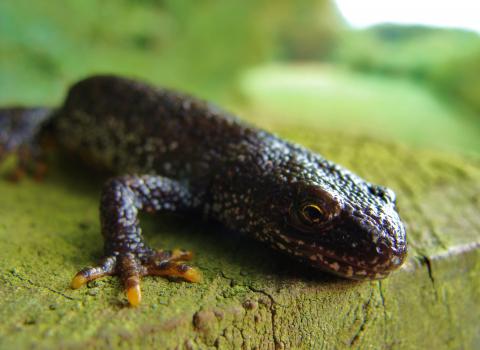Great Crested Newt (GCN) populations have continued to decline across the country despite their status as a UK and European protected species.
This is mainly due to the loss of their breeding ponds, which, if neglected, scrub over and eventually dry out. Further habitat has been lost through agricultural intensification and development.
Great Crested Newts are dependent on water-bodies for breeding but spend most of their lives foraging on land within approximately 250 metres from their breeding ponds. This means populations can be impacted when land is developed, even when breeding ponds are retained.
Although there are some excellent newt mitigation schemes, which have delivered real gains for GCN, unfortunately many are badly designed and have not managed to safeguard existing populations.
It has long been recognised that a different approach is required to enable Great Crested Newt populations to recover to ‘Favourable Conservation Status’, a term used to describe stable or expanding species’ populations.
‘District Level Licensing’ is an innovative new approach that has been developed by Natural England with input from the Cheshire Wildlife Trust. The scheme focusses on the recovery of GCN at a landscape scale, providing compensatory habitat away from developments where it is more likely to provide a safe-haven for GCN populations to increase in size and to expand into suitable surrounding habitats.
If the scheme is a success the result should be a win-win for both newts and developers, as better habitat will be provided and costly delays at the development site will be avoided. Although the new licence will mean no legal requirement to capture or exclude newts, the published guidance should help ensure any newts discovered on site will be moved out of harm’s way.
The Local Planning Authority could also request that non-licensed amphibian mitigation measures are undertaken on-site. Under new mandatory Biodiversity Net Gain requirements it is likely that many on-site ponds will be retained in addition to any new off-site habitat creation.
GCN are not distributed evenly across Cheshire, they are more likely to be found in areas with a high density of ponds and suitable terrestrial habitat. The new scheme recognises these differences and red, amber and green Risk Zones have been mapped to correspond to the likelihood of GCN presence. In the absence of recent survey data the Risk Zone in which a development site falls will determine how much compensatory habitat will be created.
Developments that fall within the highest Risk Zone (red zone covering less than 1% of Cheshire) will not be able to participate in the new scheme as the populations here are considered too important to affect. The scheme has been devised to deliver at least four new ponds for every GCN occupied pond that is ‘lost’ as a result of development and indirect impacts on off-site ponds will also be accounted for.
The Cheshire Wildlife Trust is hopeful that this new approach will see populations of Great Crested Newts in Cheshire start to recover after years of decline. Our organisation is currently acting as a habitat delivery body for the new scheme, so we are confident that the ponds we create will be able to support GCN in the long term.
The compensation sum paid by developers will ensure ponds are monitored and managed for at least 25 years. This approach is likely to result in higher quality ponds than those created within development sites under the conventional approach to mitigation. We are optimistic that restoring farmland ponds and creating new ones at a rate greater than they are lost to development will not only benefit newts, but will have additional benefits for other declining pond species.
The Cheshire Wildlife Trust would like to hear from you if you’re a landowner and you are interested in helping us provide new habitat for newts as part of this scheme.
Please read the FAQ fact sheet below regarding the great crested newt district level licensing.

